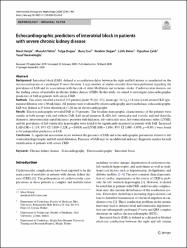Echocardiographic predictors of interatrial block in patients with severe chronic kidney disease

Göster/
Tarih
2020Yazar
Kalcik, MacitYetim, Mucahit
Dogan, Tolga
Eser, Baris
Dogan, Ibrahim
Bekar, Lutfu
Karavelioglu, Yusuf
Çelik, Oğuzhan
Üst veri
Tüm öğe kaydını gösterÖzet
Background Interatrial block (IAB), defined as a conduction delay between the right and left atrium, is manifested on the electrocardiogram as a prolonged P-wave duration. Large number of studies recently have been published regarding the prevalence of IAB and its associations with the risk of atrial fibrillation and ischemic stroke. Cardiovascular diseases are the leading causes of mortality in chronic kidney disease (CKD). In this study, we aimed to investigate echocardiographic predictors of IAB in patients with severe CKD. Methods This study enrolled a total of 155 patients [male: 95 (61.3%), mean age: 56.3 +/- 12.8 years] with severe CKD (glomerular filtration rate < 30 mL/min). All patients were evaluated by electrocardiography and transthoracic echocardiography. IAB was defined as P wave duration of >= 120 ms on electrocardiography. Results Electrocardiography revealed IAB in 54 patients. The baseline demographic characteristics of the patients were similar in both groups with and without IAB. Left atrial diameter (LAD), left ventricular end-systolic and end-diastolic diameters, interventricular septal thickness, posterior wall thickness, left ventricular mass, left ventricular mass index (LVMI), and the prevalence of left ventricular hypertrophy were found to be significantly increased in patients with IAB. Increased LAD (OR = 1.119; 95% CI 1.019-1.228; p = 0.019) and LVMI (OR = 1.036; 95% CI 1.003-1.070; p = 0.031) were found to be independent predictors of IAB. Conclusion A significant association exists between the presence of IAB and echocardiographic parameters related to left ventricular hypertrophy and left atrial dilatation. Presence of IAB may be an additional and easy diagnostic marker for risk stratification of patients with severe CKD.

















